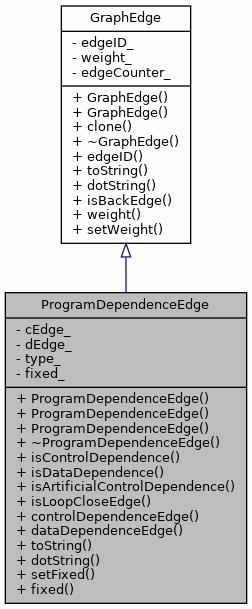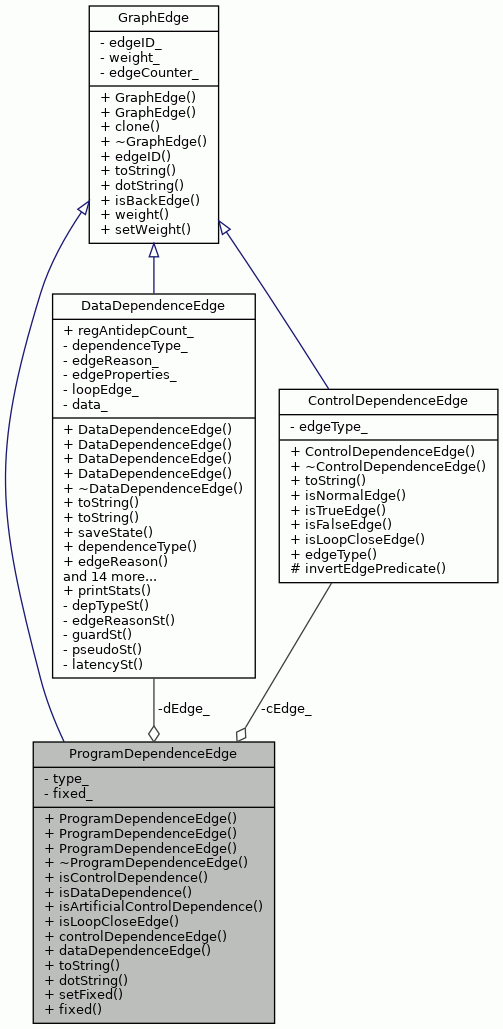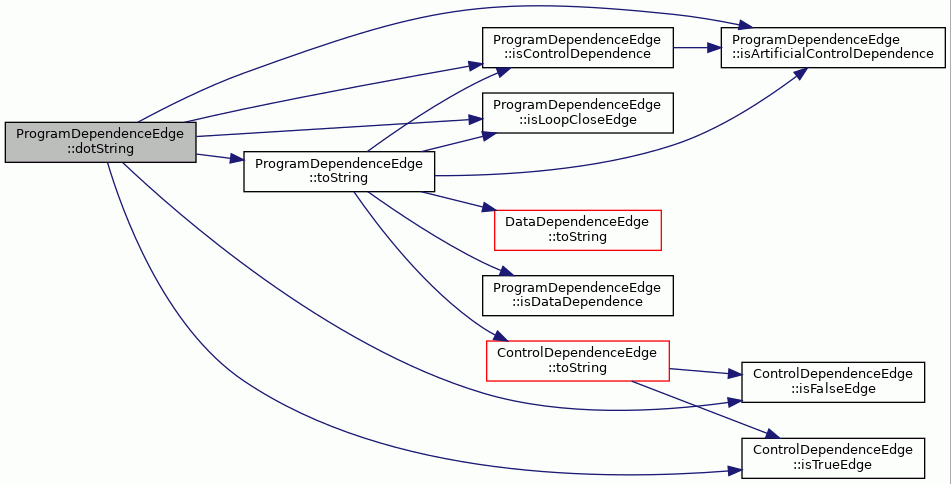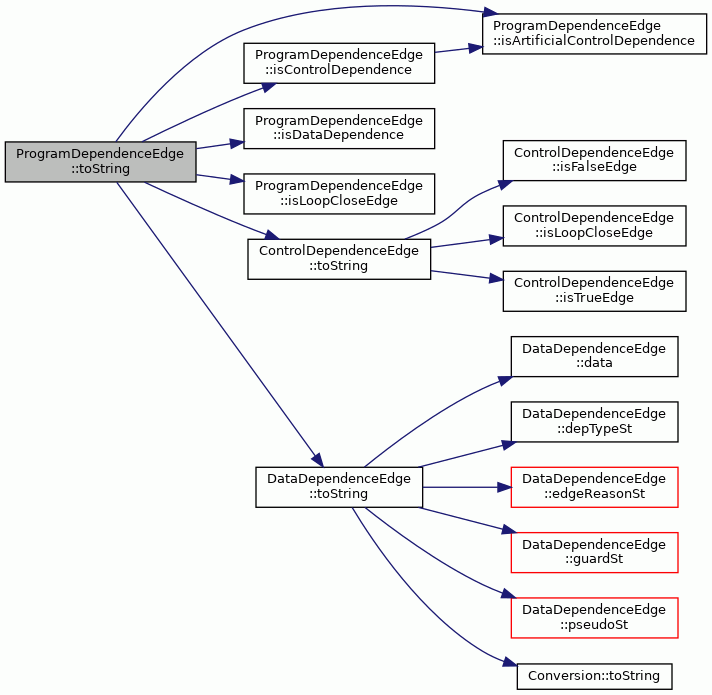#include <ProgramDependenceEdge.hh>


Public Types | |
| enum | EdgeType { PDG_EDGE_CONTROL, PDG_EDGE_DATA, PDG_EDGE_LOOP_CLOSE, PDG_EDGE_CONTROL_ARTIFICIAL } |
Public Member Functions | |
| ProgramDependenceEdge (ControlDependenceEdge &cEdge) | |
| ProgramDependenceEdge (DataDependenceEdge &cEdge) | |
| ProgramDependenceEdge (EdgeType type=PDG_EDGE_CONTROL_ARTIFICIAL) | |
| virtual | ~ProgramDependenceEdge () |
| bool | isControlDependence () const |
| bool | isDataDependence () const |
| bool | isArtificialControlDependence () const |
| bool | isLoopCloseEdge () const |
| ControlDependenceEdge & | controlDependenceEdge () |
| DataDependenceEdge & | dataDependenceEdge () |
| TCEString | toString () const |
| TCEString | dotString () const |
| void | setFixed () |
| bool | fixed () |
 Public Member Functions inherited from GraphEdge Public Member Functions inherited from GraphEdge | |
| GraphEdge () | |
| GraphEdge (const GraphEdge &edge) | |
| virtual GraphEdge * | clone () const |
| virtual | ~GraphEdge () |
| virtual int | edgeID () const |
| virtual bool | isBackEdge () const |
| int | weight () const |
| void | setWeight (int w) |
Private Attributes | |
| ControlDependenceEdge * | cEdge_ |
| DataDependenceEdge * | dEdge_ |
| EdgeType | type_ |
| bool | fixed_ |
| Set to fixed if edge is not to be moved any more while serializing. More... | |
Detailed Description
Definition at line 41 of file ProgramDependenceEdge.hh.
Member Enumeration Documentation
◆ EdgeType
Definition at line 43 of file ProgramDependenceEdge.hh.
Constructor & Destructor Documentation
◆ ProgramDependenceEdge() [1/3]
| ProgramDependenceEdge::ProgramDependenceEdge | ( | ControlDependenceEdge & | cEdge | ) |
Constructor, makes new Program Dependence Edge with reference to original Control Dependence Edge in CDG.
- Parameters
-
cEdge Control Dependence Edge
Definition at line 50 of file ProgramDependenceEdge.cc.
References ControlDependenceEdge::isLoopCloseEdge(), PDG_EDGE_CONTROL, PDG_EDGE_LOOP_CLOSE, and type_.

◆ ProgramDependenceEdge() [2/3]
| ProgramDependenceEdge::ProgramDependenceEdge | ( | DataDependenceEdge & | dEdge | ) |
Constructor, makes new Program Dependence Edge with reference to original Data Dependence Edge in DDG.
- Parameters
-
dEdge Data Dependence Edge
Definition at line 65 of file ProgramDependenceEdge.cc.
◆ ProgramDependenceEdge() [3/3]
| ProgramDependenceEdge::ProgramDependenceEdge | ( | EdgeType | type = PDG_EDGE_CONTROL_ARTIFICIAL | ) |
◆ ~ProgramDependenceEdge()
|
virtual |
Member Function Documentation
◆ controlDependenceEdge()
| ControlDependenceEdge & ProgramDependenceEdge::controlDependenceEdge | ( | ) |
Returns reference to control dependence edge of CDG.
- Returns
- control dependence edge of underlying CDG
Definition at line 166 of file ProgramDependenceEdge.cc.
References __func__, and cEdge_.
Referenced by ProgramDependenceGraph::processPredicate().
◆ dataDependenceEdge()
| DataDependenceEdge & ProgramDependenceEdge::dataDependenceEdge | ( | ) |
Returns reference to data dependence edge of CDG.
- Returns
- data dependence edge of underlying DDG
Definition at line 179 of file ProgramDependenceEdge.cc.
References dEdge_.
Referenced by ProgramDependenceGraph::moveDDGedges().
◆ dotString()
|
virtual |
Returns the edge description as a string in .dot format.
- Returns
- string describing the edge payload in .dot format
Reimplemented from GraphEdge.
Definition at line 101 of file ProgramDependenceEdge.cc.
References cEdge_, isArtificialControlDependence(), isControlDependence(), ControlDependenceEdge::isFalseEdge(), isLoopCloseEdge(), ControlDependenceEdge::isTrueEdge(), and toString().

◆ fixed()
|
inline |
◆ isArtificialControlDependence()
| bool ProgramDependenceEdge::isArtificialControlDependence | ( | ) | const |
Tests if edge is artificial control dependence type. Artificial edges are added during PDG synchronization.
- Returns
- true if edge is artificial control dependence
Definition at line 147 of file ProgramDependenceEdge.cc.
References PDG_EDGE_CONTROL_ARTIFICIAL, and type_.
Referenced by dotString(), isControlDependence(), ProgramDependenceGraph::processPredicate(), and toString().
◆ isControlDependence()
| bool ProgramDependenceEdge::isControlDependence | ( | ) | const |
Tests if edge is control dependence type.
- Returns
- true if edge is control dependence
Definition at line 126 of file ProgramDependenceEdge.cc.
References cEdge_, isArtificialControlDependence(), PDG_EDGE_CONTROL, and type_.
Referenced by dotString(), and toString().

◆ isDataDependence()
| bool ProgramDependenceEdge::isDataDependence | ( | ) | const |
Tests if edge is data dependence type.
- Returns
- true if edge is data dependence
Definition at line 137 of file ProgramDependenceEdge.cc.
References dEdge_, PDG_EDGE_DATA, and type_.
Referenced by ProgramDependenceGraph::removeGuardedJump(), and toString().
◆ isLoopCloseEdge()
| bool ProgramDependenceEdge::isLoopCloseEdge | ( | ) | const |
Tests if edge is loop close edge from artificial close node to loop entry node
- Returns
- true if edge is loop close edge
Definition at line 157 of file ProgramDependenceEdge.cc.
References PDG_EDGE_LOOP_CLOSE, and type_.
Referenced by dotString(), and toString().
◆ setFixed()
|
inline |
◆ toString()
|
virtual |
Returns the edge description as a string.
- Returns
- string describing the edge payload
Reimplemented from GraphEdge.
Definition at line 81 of file ProgramDependenceEdge.cc.
References cEdge_, dEdge_, isArtificialControlDependence(), isControlDependence(), isDataDependence(), isLoopCloseEdge(), ControlDependenceEdge::toString(), and DataDependenceEdge::toString().
Referenced by dotString().

Member Data Documentation
◆ cEdge_
|
private |
Definition at line 68 of file ProgramDependenceEdge.hh.
Referenced by controlDependenceEdge(), dotString(), isControlDependence(), and toString().
◆ dEdge_
|
private |
Definition at line 69 of file ProgramDependenceEdge.hh.
Referenced by dataDependenceEdge(), isDataDependence(), and toString().
◆ fixed_
|
private |
Set to fixed if edge is not to be moved any more while serializing.
Definition at line 72 of file ProgramDependenceEdge.hh.
Referenced by fixed(), and setFixed().
◆ type_
|
private |
Definition at line 70 of file ProgramDependenceEdge.hh.
Referenced by isArtificialControlDependence(), isControlDependence(), isDataDependence(), isLoopCloseEdge(), and ProgramDependenceEdge().
The documentation for this class was generated from the following files:
 1.8.17
1.8.17